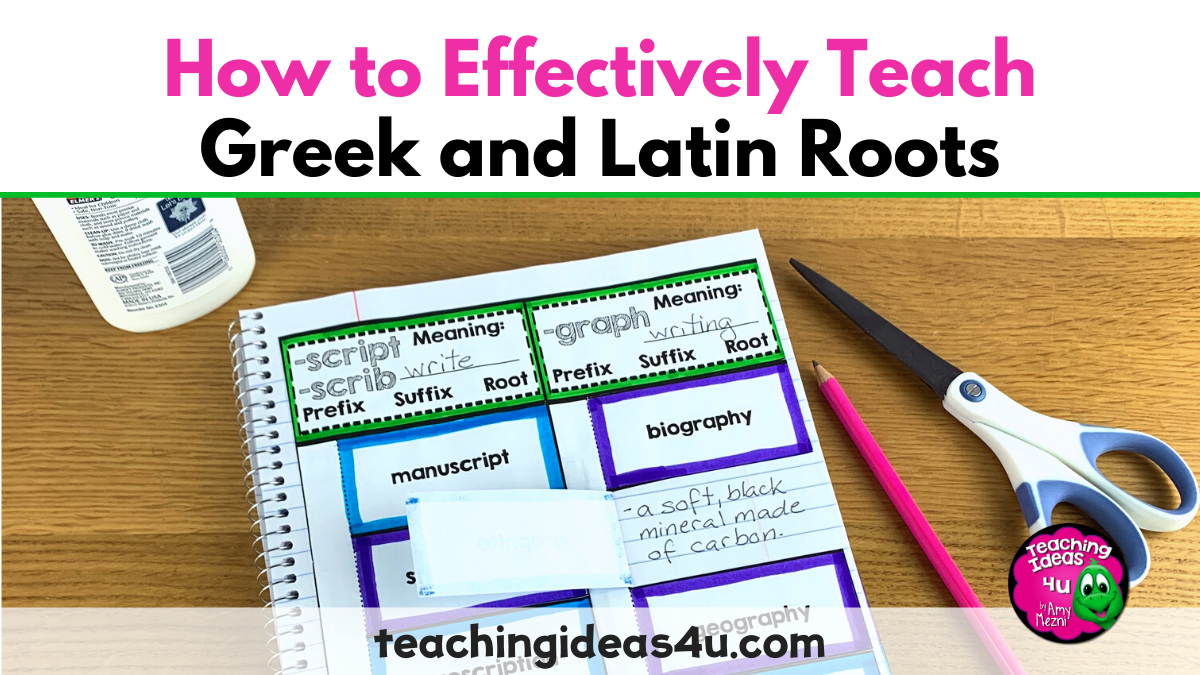How to Effectively Teach Greek & Latin Roots
Students receive many benefits from learning Greek and Latin roots. Knowing roots and affixes can help students determine the meaning of new words, as English contains many words based on Greek and Latin.
This knowledge helps students to become better readers. It also helps students perform better on tests like the SAT.
How can teachers help students learn these roots?
I taught Greek and Latin roots to fourth and fifth graders. Vocabulary instruction can be meaningful – or students can memorize the words and then promptly forget them after the test.
By the end of this post, you will learn five strategies that will help your lessons be more effective and improve your students’ retention of the words.
1. Focus on a Limited Word List
In general, I find teachers and textbook companies overwhelm students with long spelling and vocabulary lists. Students who are strong in verbal skills quickly learn the words, while other students struggle and remember very little.
Limiting the number of words helps all students retain what they have learned. After all, by learning the roots and affixes, students should be able to apply this knowledge to new vocabulary words.
I recommend lists of no more than ten words. Students learn enough words to see how the root or affix used, and they can easily practice ten words in one class activity.
By the end of the week, they can see and use the words multiple times, increasing their opportunities to move the vocabulary to long-term memory.
I used my Greek and Latin word list as both spelling and vocabulary. This increased the likelihood of students learning the words, as well as making it easier for me to teach both in a limited amount of time.
2. Intentionally Teach Root and Affix Connections in Words
One mistake some teachers make is to not expressly explain and point out the root or affix in every word. Repeat these connections multiple times during the week.
Students don’t always get it the first – or second – time. For example, my son’s Latin teacher gives his classes SAT words with Latin roots. I am sure he pointed out how the words are directly correlated to the Latin word, but my son still did not make the connection until I pointed it out again.
I used interactive templates with upper elementary students when I introduced new words. By providing these words, I knew the words were spelled correctly. (Students with vision processing issues and dyslexia struggle to copy from the board.) The students could also highlight the word roots to make the relationship more obvious.
3. Explain the Affixes' Relationship to Parts of Speech
Grammar is often not taught, or it is given superficial treatment. It isn’t that teachers don’t think grammar is important, but classroom minutes are limited, and there is so much for teachers to cover.
Emphasizing parts of speech is an excellent way to reinforce grammar – and it helps students to understand how a word is used. For example, -ist means “a person who.” Any word that ends in -ist will be a person, which will always be nouns.
4. Practice, Practice, Practice
Students need to use the word repeatedly to remember them. Students must connect new words to things they already know, as these connections help them retrieve information from their memory. (This is also why making connections between the words on the word list helps students remember them.) With my students, we began by learning the word meanings and identifying the root or affix. Sometimes we would also make Frayer models to form connections with the words.
Later in the week, students would use the new words in a variety of activities. On the second day, I gave students different journal options. The next day students used the words in an interactive way – Pictionary, dominoes, matching, color-by-number, or other activity. For the final practice day, students worked on a worksheet activity. I varied these so they wouldn’t become routine. Each week would rotate through matching, analogies, synonyms & antonyms, crossword puzzles, and fill-in-the-blank. Finally, students would take a test on the words and be assessed on both spelling and definitions.
5. Use the Vocabulary Words in Your Speech
Continually reinforce new vocabulary by using them when you talk to your students. If students only learn the words for a week then never hear them again, they will forget most of what they’ve learned. Intentionally using the words helps students spiral what they previously learned.
6. Ask Students to Find More Related Words
I remember when my second-grade teacher had students bring in homophones. If students brought in a new pair, they would write the words on paper leaves and add them to our “homophone tree.” I enjoyed looking for and finding homophones – and I know other students did, too, because our tree grew quickly.
Teachers can use this same activity with Greek and Latin families. I used our classroom cupboard doors for our “word wall,” as the room did not have many bulletin boards. Teachers could hang each word root and add vocabulary words after the test. Throughout the year, students could add related words to each list. Be sure to have students check the word history, as sometimes words look like they are related, but they aren’t. This can be done with a dictionary (print or online.)

